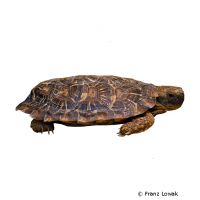Pancake Tortoise (Malacochersus tornieri)
| Pancake Tortoise Malacochersus tornieri | |
|---|---|
| Name | Pancake Tortoise |
| Name Lat. | Malacochersus tornieri |
| Family | Tortoises |
| Family lat. | Testudinidae |
| Order | Turtles |
| Order lat. | Testudines |
| Origin | Southeast Africa |
| Habitat | Shrub savanna |
| Diet | Herbs, grass, succulents |
| Humidity | 40-60 % |
| Behavior | Peaceful |
| Keeping | Individual, harem |
| Care Level | Moderate |
| Reproduction | Oviparous |
| Housing | Dry terrarium |
| Life Span | 30-40 years |
| Protection | CITES Appendix I; EU Annex A |
| Metric Units | |
| Size | 15-20 cm |
| Temperature | 24-28 °C |
| Temperature Local | 35-45 °C |
| Housing Size | 120 x 50 x 50 cm |
| US Units | |
| Size | 6"-8" |
| Temperature | 75-82 °F |
| Temperature Local | 95-113 °F |
| Housing Size | 50" x 20" x 20" |
Distribution and habitat
The distribution area of the slatted tortoises is in Kenya and Tanzania in East Africa. They inhabit dry thornbush savannahs and kopje rocks (inselbergs) up to 1,800 m above sea level. Good climbers, they usually stay near rock crevices into which they quickly retreat for protection. The toes of the front and hind legs are equipped with strong claws.
Maintenance
Minimum dimensions for the terrarium, according to the size and number of animals:
| floor space for 1-2 animals | 3PL x 1,5PL (L x W) |
The carapace length (PL) is measured on the largest animal. For each additional animal the floor space has to be increased by10%, from the 5th animal on by 20%. A terrarium of e.g.120 x 50 x 50 cm is recommended, which should be placed in a quiet and vibration-free place
They need a spacious terrarium with flat stacked stones (rock crevices) structured, a diggable 10-15 cm deep substrate, e.g. of sand-loam-gravel mixture as well as a small, easy to clean water basin for drinking and robust dry plants for decoration. In the case of group housing, separate roosts should be provided and suitable measures for visual separation should be implemented.
| Temp. day: 24-28 °C | Temp. night: 18-22 °C | Temp. local: 35-45 °C | Humidity: 40-60 |
Thermostatically controlled floor heating is recommended. Lighting duration must be 10-14 hrs, depending on the season. They need high light intensity and daily UV irradiation as well as sunny places with radiant heat.
Diet
They feed almost exclusively vegetarian. The diet consists of a wide range of wild herbs (plantain, dandelion, etc.), dry grasses, hay and hay dressings, clover, succulents (e.g. aloe) and vegetables such as lamb's lettuce, cucumbers, zucchini and chicory, supplemented with commercial ready-made food for tortoises. Occasionally, small amounts of animal protein can be offered. Fruit should be fed sparingly and infrequently because of the fructose content. Regular addition of minerals and vitamins is important. For adult animals, one fast day per week is advisable. Drinking water must always be available. A varied diet promotes health and prevents deficiency symptoms.
Reproduction and breeding
The slightly smaller males have a much thicker and longer tail than the larger females.
Mating and egg laying, up to 6 clutches, takes place in July and August. The female buries her eggs, usually only 1 egg per clutch, about 5 cm deep, in a sandy place. The incubation period is 100-180 days at about 27-30 °C. The life expectancy can be 30-40 years.
Species protection
The animal population must be reported in writing to the competent authority immediately after the start of keeping. Subsequently, all arrivals and departures must be reported
Species protection: WA Appendix I; EU Appendix A. You will receive a CITES document with the purchase, which confirms that this animal is an offspring. Please keep the CITES document in a safe place!
In your pet store you can get more information.
Important
They can be kept well in a group, one male with 3-4 females. Males are incompatible with each other. Since their highly flattened, flexible carapace offers little protection from enemies, they usually stay hidden in crevices. Their short activity periods (15-20 minutes) are early in the morning and late in the afternoon.
During the rainy season, humidity should be increased to 60-80% (spray several times a day). They do not hibernate
The terrarium must have good ventilation without drafts and meet the species-specific needs. Measuring devices such as thermometers, hygrometers, etc. are necessary. The lighting has to correspond to the species-specific day-night rhythm and has to be placed in such a way that the animals cannot injure themselves. The terrarium should be locked in such a way that neither unauthorized persons can open it nor the animals can escape. Contamination must be removed regularly
Further literature can be found in your pet store.
References
Text: petdata; Image: Franz Lowak
Source: BMELV (1997): Tierschutzgutachten - Mindestanforderungen an die Haltung von Reptilien; ENGELMANN (2006): Zootierhaltung - Tiere in menschlicher Obhut: Reptilien und Amphibien, Harri Deutsch Verlag
- Gemäß § 21 Abs. 5 Tierschutzgesetz idgF
